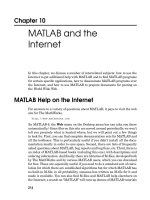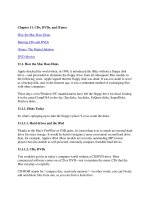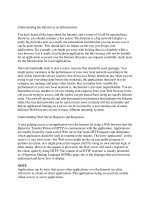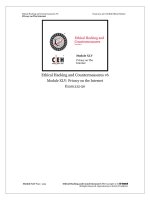How The Internet Works
Bạn đang xem bản rút gọn của tài liệu. Xem và tải ngay bản đầy đủ của tài liệu tại đây (2.12 MB, 56 trang )
How The Internet
Works
By Taty Sena,
Edited by Justin Pot
This manual is the intellectual property of
MakeUseOf. It must only be published in its
original form. Using parts or republishing altered
parts of this guide is prohibited without permission
from MakeUseOf.com
Think you’ve got what it takes to write a manual
for MakeUseOf.com? We’re always willing to
hear a pitch! Send your ideas to
; you might earn up to
$400.
Table of Contents
Introduction
A brief history about the Internet
Transferring Information
The Basic Languages and Protocols of the Web
Who runs the Internet?
Current Internet Trends
How the Web Changed the World
Cool Web Statistics
Conclusion
MakeUseOf
Introduction
It is impossible to deny the influence of the
Internet. In the 1990’s it quickly changed from an
exciting technology few understood to something
so prevalent most can’t imagine living without it.
The World Wide Web is a powerful thread that
connects the entire world, one that allows us to
share information like never before.
The benefits of accessing so much information are
too many to list, and while some problems are also
becoming apparent, the web’s place in our daily
lives is undeniable. We can now access the
Internet from our home computers, office, laptops
and our phones. But even with this close intimacy
many people still aren’t entirely sure what the
Internet is and how it really works. This guide
explores these questions, starting with a bit of
history.
A brief history of the Internet
Like most revolutionary ideas, the Internet started
with a few people who dared to dream the
impossible. The year was 1962 and Leonard
Kleinrock (pictured) at MIT had just published the
first paper on packet switching theory, which was
the technology that allows information to be
transferred as packets of information. At the same
time, a man named J.C.R. Licklider of MIT wrote a
series of memos describing a "Galactic Network,"
which would allow people to access information
from anywhere.
The story could have ended there. But, as it
happens, Licklider was the first head of the
computer research program at DARPA (the
research and development office for the U.S.
Department of Defense), and convinced his
successors that researching networking processes
was an important undertaking.
In 1965, MIT researcher Lawrence G. Roberts,
along with Thomas Merrill, connected the TX-2
computer in Massachusetts to the Q-32 in
California with a low speed telephone line. This
project, sponsored by ARPA, intended to study a
"cooperative network of time-sharing computers”.
That was the first time a long distance computer
network was created, and it helped show
researchers that it could work— although it also
showed them how inadequate phone lines were for
the transmission of information. In 1966, using the
knowledge he had acquired from his previous
experiment, Roberts put together plans for the
creation of the “ARPANET”, which would
eventually become the modern “Internet”.
Early Development
The development of the ARPANET was not
without major glitches. Charley Kline at UCLA
sent the first packet ever using the network as he
tried to connect to Stanford Research Institute on
Oct 29, 1969. The first word he tried was LOGIN,
but the system crashed when he reached the letter
G.
By 1972 Ray Tomlinson created email for the
ARPANET and started using the symbol “@” for
email addresses.
In 1973, a protocol called FTP (File Transfer
Protocol) was created to allow files to be
transferred to hosts as sites (more on that below).
That is the protocol used today to upload files to
servers and websites.
By 1981, Listserv software made the exchange of
information easier, and by the 1980’s, the first
private ISP (Internet Service Provider) appeared.
The Internet started to become broadly used in the
1990’s. The first search engine— Archie, from
McGill University in Montreal—was created. This
was followed in 1991 by WAIS and Gopher.
Lycos was created in 1993 and Yahoo was
founded in 1994, but the major change in how
people searched the web happened in 1998, with
the launch of a clean and efficient little search
engine called Google.
Current
Although Google cannot be credited with the
development of the web since the late 1990’s, it
serves as a major turning point in its popular
acceptance. Within a short time, “to Google”
would become a verb synonym to searching the
web.
During the 90’s major investments had been made
in the field of technology, and investors and
companies saw the web as the new portal for their
investments. So many of those investments went
badly that 2000 is known as the year the dot-com
bubble burst, with the majority of the high
investment dot-coms going down during 2001 and
2002.
The irony of the dot-com bubble burst is that the
Internet would, in the years after the burst, prove
itself immensely profitable and a major focus of
investments once again.
It matured to become such a part of people’s lives
that it had begun to threaten the existence of
companies that refused to create a strong presence
online.
Transferring Information
Computers
From the users’ end, computers are a direct link to
the Internet. A computer with Internet access is
necessary for retrieving files served by websites.
Most computers are adequate for that task, but
naturally as the web grows more and more
complex so does the computing power needed to
take advantage of it.
Cables
There are currently a few different types of cables
that can be used to connect a computer to the
Internet. The most common ones are phone lines
(for DSL and modem users) and Broadband RJ-45
(ethernet) cables. The phone line can connect users
to a modem connection directly, or be connected to
a router for DSL users, and then to an RJ-45 cable.
Broadband cable and T1 users don’t use a phone
line, but use HFC and RFoG networks instead.
(Left to right, RJ connectors: an eight-pin RJ-45
plug, six-pin RJ-25 or RJ-12 plug, four-pin RJ-11
or RJ-14 plug, and a four-pin RJ-22 (RJ-10 or RJ-
9) handset plug)
ISPs (Internet Service Providers)
Internet service providers are the companies that
you pay to get Internet delivered to your house or
workplace, such as Time Warner Cable, Comcast
or Verizon DSL. They are the links between you
and the large network we call the Internet, so by
paying a fee they can give you access to their
infrastructure and connect you to other computers.
What you are really paying for is for the usage of
their hardware: their cables, computers, routers,
modems, the workers who maintain them and the
real estate that is required to hold that hardware.
The Internet itself and the information stored in it
is, for the most part, free; without an ISP, however,
you would not have access to it.
Hosts, Servers
The information you see online needs to be stored
by computers called hosts, or servers, which are
constantly sending the information to the World
Wide Web. Most major web hosting companies
have huge buildings with hundreds or thousands of
servers to store the websites they host. When you
type a website address on your browser, they
receive the request and send out the information
that appears on your browser.
You can turn your own computer into a server, but
it would probably serve the pages slowly if many
people are trying to access the site at once.
IPs (Internet Protocol) Addresses
Websites, computers on a network and hosts are
identified by a series of numbers called IP
addresses. Even your computer has an IP address;
you can find it by visiting sites such as
/>Websites have public IP addresses, which are their
identifiers online. For example, we all know that
to reach Google, you can type Google.com on the
address bar. Google’s real IP is 66.102.7.99 , so if
you type that on the address bar, you will also find
Google.
This is how it works:
Let’s say your address is 125 Happy Street, but
you decide to put a sign on your door that says
“Bob’s House”, which covers the street number.
You can then tell your friends to look for “Bob’s
House”, which would be easier for them to
remember, but your real address still is 125 Happy
Street. In this analogy, then, “Bob’s house” is your
Domain Name (below) and 125 Happy Street is
your IP number.
Makeuseof.com’s IP address and server location.
DNS (Domain Name System)
The domain name is basically the address of your
website, a nickname for its IP address. Domains
can be assigned to IPs by a Domain Name Registry
headed by the Internet Assigned Numbers
Authority (IANA).
Basically, you can go to a registrar, such as
GoDaddy.com or NetworkSolutions.com, purchase
a domain and point it to where your site is hosted,
so that when people type in your web address, they
are taken to your website.
Domains are divided into levels from right to left.
For example, let’s take the domain:
The top level domains are the ending part of the
address. In this case, the .org and the mid level
domain in this case would be beholders.
Some of the most common top level domains are:
com - commercial business
gov - Government agencies
edu - Educational institutions
org - Organizations (non-profit)
mil - Military
net - Network organizations
There are currently 21 generic top-level domains
and 250 two-letter country-code top-level
domains. Some of those are:
.br for Brazil
.fr for France
.in for India
URLs
URLs are shortcuts to a particular part of a Domain
Name. Although sometimes people will use the
two names interchangeably, there is a main
difference. The Domain Name includes all the
URLs within that domain. The URL points to a
particular location, for example:
Beholders.org is the Domain name, but let’s say I
want to point someone to a particular page on that
site such as:
/>That would be a URL within the domain
Beholders.org.
The confusion exists because most people will say,
what is the URL for the site and they are given the
simplest URL form, where the home of the site is
(beholders.org), which also happens to be the
Domain Address of the site.
The URL usually includes much more information
though, such as the specific page address, folder
name, and protocol language.
In the case above:
/>http:// - Hypertext Transfer Protocol
www. – World Wide Web
beholders.org/ – The Domain Name
beholdersgroup/ – Folder or sub-category where
the page is.
projectswesupport. – Name of the page where the
information can be found.
html – Language protocol used to write the page.
Protocols of the Web
Protocols are different rules and languages that are
used to exchange information or data. Below are
some examples of the most used web protocols.
HTML
HTML (HyperText Language Markup) was
developed around 1991 and originally had 20 tags.
HTML has, almost since the beginning of websites,
been one of the main languages used to
communicate information, particularly for the
creation of websites. HTML is considered a static
language, because for the most part, what is written
on the page is displayed on the browser, with very
little interactivity between the user and that
Below is a sample of HTML code:
Most sites in the world make use of at least some
html to display their information, although many
larger sites being created today are connected to
some form of database and use other languages
which are considered more “dynamic” than HTML
is. You can view the code on most webpages by
using the view source option in your browser.
Most of what you will see is HTML, since
dynamic sites hide their real code when displayed
that way for security reasons.
Details on the current version of HTML (4.01) can
be found at: />PHP, ASP and Databases
Database driven sites are called “dynamic” sites
because, unlike HTML, they don’t store the
information that will appear on the pages on the
code itself. The code of dynamic sites is usually a
portal to a database. They are what we call
“queries”. What that means is that they are
requests, or questions, that can be answered by a
database, which is where the real data is
displayed. Dynamic sites can also write to a
database, and that
So for example, let’s say that a dynamic site has a
form to create a user for that site. You type in your
information and click “send” or “join”, or a button
of that sort. The form will send that information to
a database, and tell it to store it on a particular part
of the database with tags for your name, address,
password, etc.









